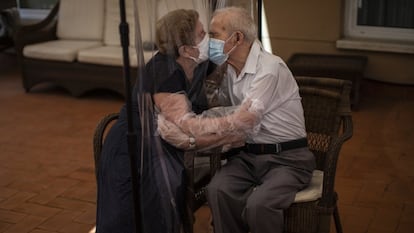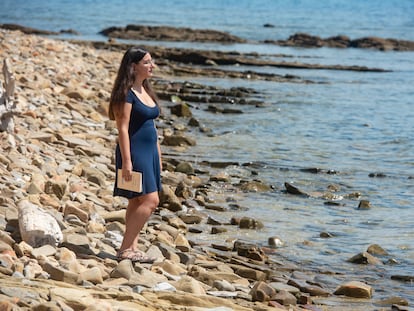Emilio Morenatti: ‘I would give up the Pulitzer to have my leg back. I’d even burn my work’
Recognized for his poignant series of images of the pandemic, the award-winning photojournalist talks to EL PAÍS about disability and the role of photography in society
Emilio Morenatti gets off the high-speed Barcelona-Madrid AVE train with his camera at the ready, even though he’s not on a job. The camera, he says, is his third arm. Dressed in a polo shirt and long pants, it’s impossible to tell he is missing his left leg.
Morenatti’s leg was blown off in 2009 by a bomb in Afghanistan when he was accompanying US troops on a mission that he was advised against going on.
The chief photographer for the Associated Press in Spain and Portugal is now waiting for a visa to enter the US and collect the Pulitzer Prize for his photos of the elderly and homeless in Barcelona during the worst of the coronavirus pandemic. Morenatti says he is proud that, after all the restrictions he had to work around in order to take them, his photos were displayed as part of a state tribute to Covid victims. If he feels at all bitter about the obstacles that were put in his path, it doesn’t show.
Question. Is the revenge sweet?
Answer. In a way, yes. The authorities that asked for the photos are the same ones who denied us photographers access to hospitals and cemeteries. I could have refused them, but I am more interested in exposing the hypocrisy. We live in an aseptic society that doesn’t want to see certain things. But I think with this pandemic, there’s been a click. Something has changed. If this means making people think, I feel I have done my job.
Q. The Pulitzer is like the Nobel Prize of its field. What now?
A. Just keep working. If losing a leg – with all the family, professional and self-imposed pressures that entailed – didn’t detract from my passion or distract me from pursuing my career, this won’t either, even less so. That’s what I want to shield against; I still don’t want to sit down and edit someone else’s photos.
Q. Did the loss of your leg alter your perspective?
A. Yes, in particular my approach to victims. I feel vulnerable now; I see my two-legged colleagues and I’m the only one with one leg and I feel envious. I don’t hide my disability and, when I portray the vulnerable, I take certain liberties, as one cripple to another. It gives you empathy and the freedom to push through certain barriers.
The beauty of a photo is about trapping the viewer; it’s like those carnivorous flowers that attract you with their colors and then ensnare you
Q. “From one cripple to another!” That’s good but also tough.
A. A lame guy who saw my prosthesis once said to me, “I’m going to talk to you as one cripple to another” and I thought it was a great idea. Because being lame is not only physical, it’s mental. I miss my leg every day. Disability causes friction, pain and frustration. My mind gets used to it, but I deal with it every day. Before, I would go for a walk without thinking. Now, every outing requires logistics. It is not easy. It’s a subject that interests me a lot. That’s why the limp comes through in some of my photos.
Q. During lockdown, you went out to visit the sick with health workers. Did you also give a bit of that side of yourself to the people you photographed?
A. It felt a bit like that, yes. The elderly were very much in need of company, of human contact, of someone to pay them a visit. The doctors made the visit, but I went with them. In the Pulitzer series, there is a photo in which an old woman holds the doctor’s hand and also my own, while I took her picture with the other one. She started telling us about her life. That is also therapy, isn’t it? We could feel that people needed that support. And me too, of course.
Q. Is the camera your shield or weapon?
A. It is a part of me. Sometimes it is a shield. I have been very moved by some of the photos I have taken; they have been moments of great intensity. I remember [nursing home residents] Agustina and Pascual’s kiss that made me cry and, right then, I do remember I was using the camera as a shield. But the question is what it would be like for me not to have the camera. And that is Murphy’s Law. The day you don’t take it out with you, something happens, and that really tortures me: the photos I haven’t taken.

Q. What are the images you can’t get out of your head?
A. I remember an explosion in Gaza that landed very close to us. Those bombs are enormously violent. Everything inside you moves. There is a moment of silence, because your eardrums are blocked, and then you see smoke, people running and people who can’t run because they are dead, wounded, dismembered. I go over these kinds of situations in my head. And when it happened to me, when my leg was blown off, I watched the man who gave me a tourniquet and saved my life as if it was happening in slow motion. That slowness is something that happens again and again in my life. It is all accompanied by smells, screams, pain, nausea, all of which will accompany you all your life because your photo will never match the level of violence of a situation like that.
Q. But it is the photo that remains when the situation is over.
A. That is the privilege of this profession. And that’s what keeps me tied to it. It’s a privilege like being a superhuman or superhero. I have been in extraordinary situations, and the commitment that one acquires from being there and documenting them is what makes you do your best and say: I’m going to do it better than anyone else, even better than myself. It’s pure adrenaline.
Q. You won’t remember, but I met you while you were working at the 1992 World Expo in Seville. You were a young photographer at that time with a reputation for partying.
A. No, I don’t remember you! You’ll have to show me a full-length photo of yourself from back then [laughs]. I was a kid. I was always hungover. I was consumed by the drive and arrogance of my 20s. I was born in Zaragoza because my father is a policeman and was stationed there, but I grew up in Jerez. We were a big family of modest means in a down-at-heel neighborhood. I didn’t know anything about photography or English at that time. I did a lot of crazy things. I photographed Lady Di at the Expo, I also took myself on the island of Perejil [over which a turf battle in 2002 between Spain and Morocco] in an inflatable boat, and that brazenness was the springboard for my call from Associated Press. I’ve been a bit of a kamikaze, but as far as I’m concerned surviving means squeezing the most out of things.
I don’t hide my disability and, when I portray the vulnerable, I take certain liberties, as one cripple to another
Q. Did you feel marginalized by journalists?
A. Very much so. And I still do. I see my children and I think: they are going to have everything I didn’t have. I learned to survive on the job. Then I tried to educate myself intellectually, and I continue to do so.
Q. Have you already taken your dream photo?
A. No, and it’s impossible to do so, because it would have been during the Spanish Civil War. I dream of the Battle of the Ebro, of having worked with [photographer Robert] Capa. I would have loved to do what I’m doing now at that decisive moment in Spanish history.
Q. Would you like to cover a red carpet event?
A. I think that would be a drag. I would do it, just as we photographers do other things we don’t like, but it doesn’t interest me at all, like soccer. That, for me, is not photojournalism, which I understand to be a reflection of society. That particular element of society already has too much attention and doesn’t need to be given more. I focus on places where attention is scarce. My mission is to make visible...
Q. ... what we don’t want to see?
A. Yes, so that it is discussed and not forgotten. And that’s where I think the language used has to be intelligent, because if not, there’s rejection. The beauty of a photo is about trapping the viewer; it’s like those carnivorous flowers that attract you with their colors and then ensnare you. That’s where I channel all my knowledge and 30 years of experience.
Q. Is there anything you do for pleasure to ease the suffering of injustice?
A. I would love to play the guitar. I am a lousy musician and I have already exasperated several teachers. But something happens to me: I’m practicing, I see a change of light through the window, I throw the guitar down and go out to take pictures. And that’s with just one leg. I’d have to be totally disabled to learn to play decently.
Q. How close are friends to asking you to take pictures at their weddings?
A. You’d be surprised. Friends in the south are calling me El Puli [after the Pulitzer], which is a way of putting me in my place in case I get too big for my boots. The other day, a friend I used to work on a newspaper with in Jerez said, “Do you remember when I told you they were going to give you the Pulitzer for the terrible photos you took? Well, now they finally did!”
Q. Well, thank you very much, Puli.
A. Thank you, but, you know, I would give up the Pulitzer to have my leg back and be able to use two legs again. I’d even burn my work. It might contradict everything I’ve just said, but that’s how I feel.
English version by Heather Galloway.
Tu suscripción se está usando en otro dispositivo
¿Quieres añadir otro usuario a tu suscripción?
Si continúas leyendo en este dispositivo, no se podrá leer en el otro.
FlechaTu suscripción se está usando en otro dispositivo y solo puedes acceder a EL PAÍS desde un dispositivo a la vez.
Si quieres compartir tu cuenta, cambia tu suscripción a la modalidad Premium, así podrás añadir otro usuario. Cada uno accederá con su propia cuenta de email, lo que os permitirá personalizar vuestra experiencia en EL PAÍS.
¿Tienes una suscripción de empresa? Accede aquí para contratar más cuentas.
En el caso de no saber quién está usando tu cuenta, te recomendamos cambiar tu contraseña aquí.
Si decides continuar compartiendo tu cuenta, este mensaje se mostrará en tu dispositivo y en el de la otra persona que está usando tu cuenta de forma indefinida, afectando a tu experiencia de lectura. Puedes consultar aquí los términos y condiciones de la suscripción digital.
More information
Últimas noticias
Trump claims peace in Ukraine is near, but Moscow suggests otherwise
A survivor’s account of the Interoceanic Train accident: ‘We were scared because of the speed on the curve’
The Interoceanic Train, the Mexican alternative to the Panama Canal
What is known about the Interoceanic Train derailment in Oaxaca
Most viewed
- Oona Chaplin: ‘I told James Cameron that I was living in a treehouse and starting a permaculture project with a friend’
- Reinhard Genzel, Nobel laureate in physics: ‘One-minute videos will never give you the truth’
- Why the price of coffee has skyrocketed: from Brazilian plantations to specialty coffee houses
- Pablo Escobar’s hippos: A serious environmental problem, 40 years on
- Chevy Chase, the beloved comedian who was a monster off camera: ‘Not everyone hated him, just the people who’ve worked with him’











































